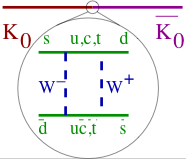This article needs additional citations for verification .(January 2025) |
This is a list of common Feynman diagrams. His first published diagram appeared in Physical Review in 1949. [1]
| Name or phenomenon | Description | Diagram |
|---|---|---|
| Beta decay and Free neutron decay | In beta decay, a beta particle is emitted from an atomic nucleus, and the nucleus gains a proton in place of the neutron. In free neutron decay, a neutron not bound to a nucleus (i.e. free) decays with the same process and products. |  |
| Compton scattering | scattering of a photon by a charged particle |  |
| Neutrino-less double beta decay | If neutrinos are Majorana fermions (that is, their own antiparticle), Neutrino-less double beta decay is possible. Several experiments are searching for this. |  |
| Pair production and annihilation | In the Stückelberg–Feynman interpretation, pair annihilation is the same process as pair production |  |
| Møller scattering | electron-electron scattering |  |
| Bhabha scattering | electron-positron scattering |  |
| Penguin diagram | a quark changes flavor via a W or Z loop |  |
| Tadpole diagram | One loop diagram with one external leg |  |
| Self-interaction or oyster diagram | An electron emits and reabsorbs a photon |  |
| Box diagram | The box diagram for kaon oscillations |  |
| Photon-photon scattering |  | |
| Higgs boson production | Via gluons and top quarks |  |
| Via quarks and W or Z bosons |  | |
| Quad cancellations | One of the many cancellations to the quadratic divergence to squared mass of the Higgs boson which occurs in the MSSM. |  |
| Primakoff effect | production of neutral pseudoscalar mesons by photons interacting with an atomic nucleus |  |
| Delbrück scattering | deflection of high-energy photons in the Coulomb field of nuclei |  |
| Deep inelastic scattering | a lepton is deflected by a virtual photon emitted by a quark from the hadron |  |
| Chiral anomaly | Anomaly-induced neutral pion decay |  |
| Flavor-changing neutral current (FCNC) | Hypothetical interactions that change the flavor of a fermion without altering its electric charge, that could happen in the standard model or beyond. |  |
